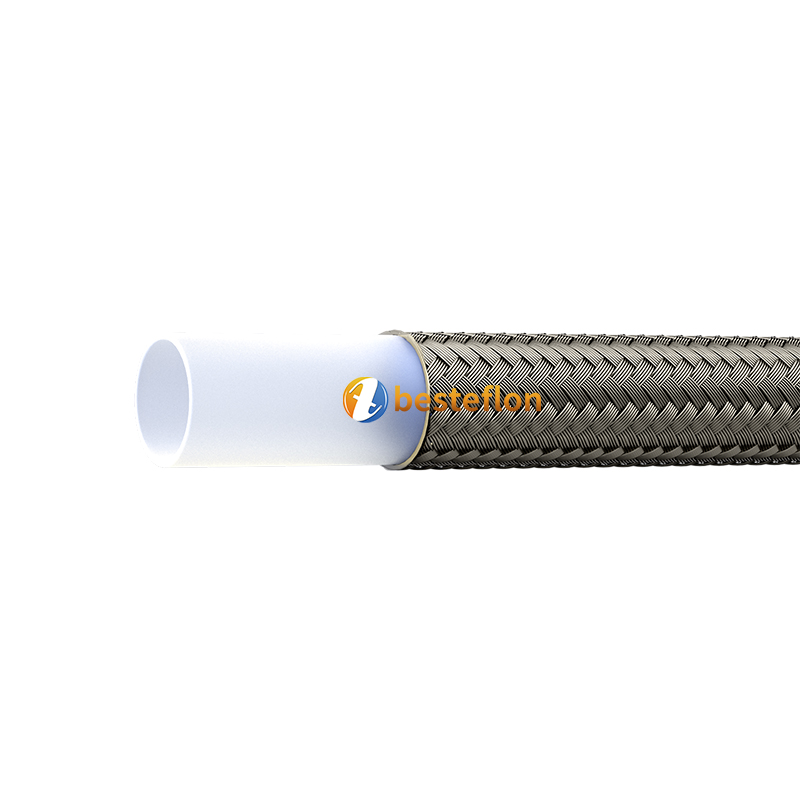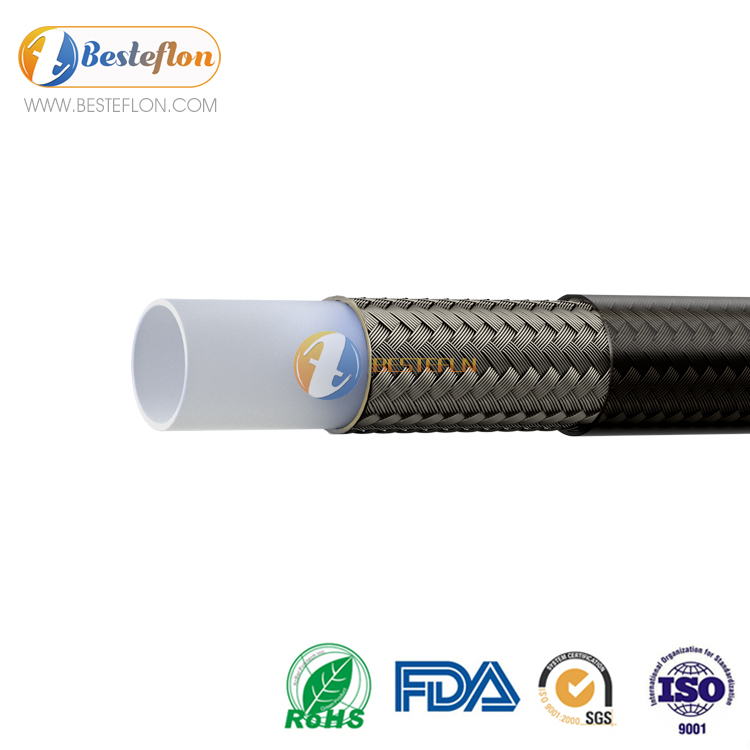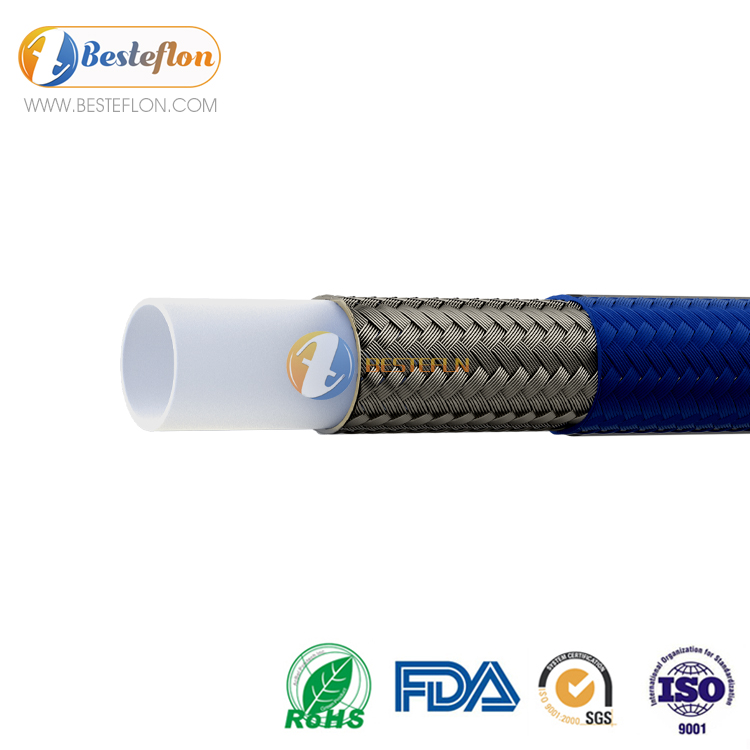What is Stainless Steel Braided PTFE Hose
PTFE hoses were initially used in hydraulic or pneumatic systems or in the aerospace sector and quickly became popular. Hoses and tubes made of polytetrafluoroethylene perform well under challenging environmental and industrial conditions, so their commercial use in industry is on the rise. Due to its high commercial availability and its excellent performance, PTFE products are important commodities in the industrial, medical and consumer markets, where they are used not only in traditional methods, but also in non-traditional and unconventional methods
What is PTFE lined hose
The PTFE hose is a tube composed of an inner PTFE lining and an outer protective cover. The PTFE liner is similar to a PTFE tube with an external protective cover, increasing its pressure resistance. The combination of outer cover and inner PTFE liner makes the hose an important tool in many applications
PTFE pipe characteristics
PTFE pipe has the following characteristics:
Heat resistance and cold resistance
preservative
No toxin, high purity
Very low permeability
Anti-fatigue
Light weight
Convenient for disinfection and cleaning
UV and ozone resistant
Chemically inert
Water resistance
Impact resistance
anti-static
lassification of PTFE pipes
The following features need to be considered for PTFE tubing when selecting them for a specific application
Smooth bore or convoluted type: The main differentiating factors in the case of PTFE hoses are the bending radius and size. The aperture of the smooth hole is less than or equal to one inch. At the same time, the bend radius of the smooth hose will be the smallest 12 inches, and the bend hole will be the smallest 3 inches
Non-conductive or conductive: Static charge is the charge generated by some medium when the charge flows through the PTFE hose at high speed. If you ignore these electrostatic charges, it may cause dangerous situations such as explosions. Therefore, PTFE hoses are sometimes made of special anti-static materials to avoid static electricity accumulation
The wall thickness of the PTFE hose: the wall thickness of the PTFE braided hose is different. In applications where hoses are severely bent, thicker walls are the first choice because they have better buckling resistance. The thick walls of the hose also provide lower permeability for the gas, but they take up more space
Braiding material: 304 stainless steel braiding is usually the material of choice in most cases. However, for offshore applications, use type 316 stainless steel braiding. In addition, if the hose is to be used in an extremely corrosive environment, the braid used should be made of stainless steel. Moreover, the braid should be made of bronze, in case the hose will be used in a high friction environment due to its good lubricating properties
Application of PTFE pipe
Oil and gas refinery
Steel Plant
power plant
Paper mill
Pharmaceutical industry
Fertilizer industry
Chemical industry
Industrial boiler
Air conditioning and refrigeration
Nuclear facility
auto industry
Ports and shipyards
By choosing the appropriate PTFE hose, the industry can take advantage of the excellent quality of PTFE and obtain numerous benefits from it. Choosing the right material will lead to better performance and ultimately a lower cost of ownership, no matter where the product is used
Stainless steel braided PTFE hose (conductive core)
Stainless steel braided PTFE hose (conductive core) chemically resistant PTFE is almost free from almost all commercial chemicals, acids, alcohols, coolants, elastomers, hydrocarbons, solvents, synthetic compounds and hydraulic oils influences. High temperature resistant, it can handle everything from low temperature to steam all in one hose. The temperature range is -65°~450°. Thanks to the anti-stick properties of PTFE, high flow rate and low friction, you will not experience low pressure drops caused by deposits on the core. Easy to clean, allowing one hose to be used in multiple applications. Flexible and lightweight, it is easier to move, handle and install than rubber hoses, and has a similar burst pressure rating. Can withstand continuous bending and vibration without failure due to bending fatigue. Moisture-proof, non-hygroscopic, ideal for pigtails in bulk gas handling and pneumatic systems, low dew point is the key. It is easy to handle non-sticky substances such as adhesives, asphalt, dyes, grease, glue, latex, lacquer and paint. Chemical inertness will not decompose or deteriorate during use. No aging, not affected by the weather, can be stored for a long time without aging. Will not age during use. Shock resistance, not affected by continuous bending, vibration or impact pressure, and can withstand alternating cycles of cold and heat
Polytetrafluoroethylene is an engineered fluoropolymer. One of its main characteristics is its outstanding resistance to chemicals; a wide temperature range of -100F to 500F (-73C to 260C) makes this The hose material is suitable for most fluids and ambient temperature conditions in the industry; a very low friction coefficient (0.05 to 0.20) can provide a non-stick surface; the water absorption of PTFE is negligible, and the ASTM test is less than 0.01%. Moreover, it is approved by the FDA for use in food and pharmaceuticals. The smooth-hole PTFE "PTFE" inner core hose is squeezed vertically to maintain the highest quality concentricity. Made of high-quality polytetrafluoroethylene resin, 304 stainless steel wire braided reinforcement, a certain amount of carbon black is added to the polytetrafluoroethylene (PTFE) core to provide a continuous conductive path for metal end fittings, and release in steam or high flow applications Static electricity. Continuous use: -65°~450°(-54°~ 232°) Intermittent use: -100°~ 500°(-73°~ 260°) Meet or exceed the requirements of SAE 100R14. PTFE meets FDA 21 CCFR 177.1550
Searches related to ptfe hose:
Post time: Mar-23-2021



